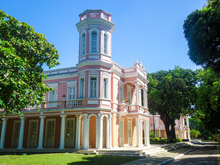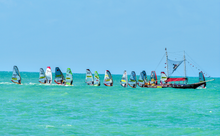Fortaleza
Fortaleza is an important industrial and commercial center of Northeast Brazil. According to the Ministry of Tourism, it is the fourth most visited city and tourist destination in the country. The BR-116, the most important highway in the country, starts in Fortaleza. The municipality is part of the Mercosur common market, and vital trade port which is closest to mainland Europe, being 5,608 kilometres (3,485 mi) from Lisbon, Portugal.
To the north of the city lies the Atlantic Ocean; to the south are the municipalities of Pacatuba, Eusébio, Maracanaú and Itaitinga; to the east is the municipality of Aquiraz and the Atlantic Ocean; and to the west is the municipality of Caucaia. Residents of the city are known as Fortalezenses. Fortaleza is one of the three leading cities in the Northeast region together with Recife and Salvador.
History
Colonial period

Colonisation began in 1603 when Portugal was part of the Iberian Union, when the Portuguese Pero Coelho de Souza constructed the Fort of São Tiago and founded the settlement of Nova Lisboa (New Lisbon). After a victory over the French in 1612, Martins Soares Moreno expanded the Fort of São Tiago and changed its name to Forte de São Sebastião.
In 1630 the Dutch invaded the Brazilian Northeast and in 1637 they took the Fort of São Sebastião and ruled over Ceará. In battles with the Portuguese and natives in 1644 the fort was destroyed. Under captain Matthias Beck the Dutch West Indies Company built a new fortress by the banks of river Pajeú. Fort Schoonenborch ("graceful stronghold") officially opened on 19 August 1649. After the capitulation of Pernambuco in 1654, the Dutch handed over this fortress to the Portuguese, who renamed it Fortaleza da Nossa Senhora de Assunção ("Fort of Our Lady of the Assumption"), after which the city of Fortaleza takes its name.
Fortaleza was officially founded as a village 1726, becoming the capital of Ceará state in 1799.
Imperial period
During the 19th century, Fortaleza was consolidated as an urban centre in Ceará, supported by the cotton industry. With the transformation of the city into a regional export center and with the increase of direct navigation to Europe, the customs building of Fortaleza was built in 1812. In 1824, the city was targeted by the revolutionaries of Confederation of the Equator.
Republican period


The city gained a number of new districts in the 1930s, including Messejana and Porangaba. In 1954, the first university in the city was created, the Universidade Federal do Ceará (UFC).
In 1983 the city started to integrate the territory of the new city of Maracanaú, which, just some years ago, was made again part of the Greater Fortaleza (the city's Metropolitan area). In the 1980s, Fortaleza exceeded Recife in population terms, becoming the second most populous city in Northeastern Brazil, with 2,571,896 inhabitants.
Geography
Climate
Fortaleza has a typical tropical climate, specifically a tropical wet and dry climate (Köppen climate classification: Aw/As), with high temperatures and relative humidity throughout the year. However, these conditions are usually relieved by pleasant winds blowing from the ocean. Average temperatures are not much different throughout the year. December is the warmest month, with a high of 31.7 °C (89.1 °F) and low of 24.9 °C (76.8 °F). The rainy season spans from January to July, with rainfall particularly prodigious in March and April. The average annual temperature is 27.0 °C (80.6 °F). The relative humidity in Fortaleza is 77.5%, with average annual rainfall of 1,584.0 millimetres (62.36 in). There is usually rain during the first seven months of the year from January to July. During this period, relative humidity is high. Fortaleza's climate is usually very dry from August to December, with very little rainfall.
Rainfall is akin to all of Northeastern Brazil among the most variable in the world, comparable (for similar average annual rainfalls) to central Queensland cities such as Townsville and Mackay. In the notorious drought year of 1877 as little as 468 millimetres or 18.43 inches fell, and in 1958 only 518 millimetres or 20.39 inches, but in the Nordeste's record wet year of 1985 Fortaleza received 2,841 millimetres or 111.85 inches.
| Climate data for Fortaleza (1991–2020 normals, extremes 1931–present) | |||||||||||||
|---|---|---|---|---|---|---|---|---|---|---|---|---|---|
| Month | Jan | Feb | Mar | Apr | May | Jun | Jul | Aug | Sep | Oct | Nov | Dec | Year |
| Record high °C (°F) | 35.2 (95.4) |
35.2 (95.4) |
34.8 (94.6) |
34.9 (94.8) |
33.6 (92.5) |
33.8 (92.8) |
33.9 (93.0) |
34.4 (93.9) |
34.6 (94.3) |
34.8 (94.6) |
34.8 (94.6) |
35.2 (95.4) |
35.2 (95.4) |
| Mean daily maximum °C (°F) | 31.2 (88.2) |
31.1 (88.0) |
30.8 (87.4) |
30.6 (87.1) |
30.8 (87.4) |
30.5 (86.9) |
30.6 (87.1) |
31.1 (88.0) |
31.4 (88.5) |
31.6 (88.9) |
31.7 (89.1) |
31.7 (89.1) |
31.1 (88.0) |
| Daily mean °C (°F) | 27.4 (81.3) |
27.3 (81.1) |
27.0 (80.6) |
26.8 (80.2) |
26.8 (80.2) |
26.4 (79.5) |
26.2 (79.2) |
26.6 (79.9) |
27.0 (80.6) |
27.4 (81.3) |
27.7 (81.9) |
27.8 (82.0) |
27.0 (80.6) |
| Mean daily minimum °C (°F) | 24.5 (76.1) |
24.3 (75.7) |
23.9 (75.0) |
23.8 (74.8) |
23.8 (74.8) |
23.2 (73.8) |
22.8 (73.0) |
22.9 (73.2) |
23.6 (74.5) |
24.3 (75.7) |
24.7 (76.5) |
24.9 (76.8) |
23.9 (75.0) |
| Record low °C (°F) | 18.2 (64.8) |
19 (66) |
18 (64) |
18.8 (65.8) |
18.6 (65.5) |
17.9 (64.2) |
17.9 (64.2) |
17.7 (63.9) |
19.2 (66.6) |
20.3 (68.5) |
20 (68) |
19.4 (66.9) |
17.7 (63.9) |
| Average precipitation mm (inches) | 156.4 (6.16) |
187.0 (7.36) |
336.9 (13.26) |
385.0 (15.16) |
229.0 (9.02) |
130.0 (5.12) |
69.7 (2.74) |
20.0 (0.79) |
13.6 (0.54) |
9.5 (0.37) |
9.8 (0.39) |
37.1 (1.46) |
1,584 (62.36) |
| Average precipitation days (≥ 1.0 mm) | 13 | 14 | 20 | 21 | 16 | 10 | 7 | 3 | 3 | 3 | 3 | 5 | 118 |
| Average relative humidity (%) | 78.4 | 80.4 | 83.0 | 85.1 | 82.6 | 79.9 | 76.9 | 73.3 | 71.7 | 72.0 | 72.7 | 74.4 | 77.5 |
| Average dew point °C (°F) | 23.6 (74.5) |
23.9 (75.0) |
24.3 (75.7) |
24.4 (75.9) |
24.0 (75.2) |
23.0 (73.4) |
22.1 (71.8) |
21.5 (70.7) |
21.6 (70.9) |
22.1 (71.8) |
22.6 (72.7) |
23.0 (73.4) |
23.0 (73.4) |
| Mean monthly sunshine hours | 220.4 | 183.0 | 172.7 | 152.8 | 211.9 | 219.2 | 254.2 | 288.5 | 287.1 | 294.2 | 287.7 | 274.2 | 2,845.9 |
| Source 1: Brazilian National Institute of Meteorology (INMET) | |||||||||||||
| Source 2: NOAA (dew point) | |||||||||||||
Vegetation
In Fortaleza there are some remaining areas of mangrove in preserved areas, including Cocó Park. Ten miles offshore is the Pedra da Risca do Meio Marine State Park, created in 1997 to protect the reefs.
Ecology and environment



The vegetation of Fortaleza is typically coastal. The restinga areas are found in dune regions near the mouths of the Ceará, Cocó and Pacoti rivers, in the beds of which there is still a mangrove forest. In other green areas of the city, there is no longer native vegetation, consisting of varied vegetation, fruit trees primarily. The city is home to seven environmental conservation units. These are the Sabiaguaba Dunes Municipal Natural Park, the Sabiaguaba Environmental Protection Area, the Maraponga Lagoon Ecological Park, the Cocó Ecological Park, the Ceará River Estuary Environmental Protection Area, the Environmental Protection Area of the Rio Pacoti and the Pedra da Risca do Meio Marine State Park. There is also, in the city, the Area of Relevant Ecological Interest of Sírio Curió, that protects the last enclave of Atlantic Forest in the urban zone.
The Cocó River is part of the river basin of the east coast of Ceará and has a total length of about 50 km in its main area. The park is inserted in the area of greater environmental sensitivity of the city, where it is possible to identify geoenvironmental formations such as coastal plain, fluvial plain and surface of the coastal trays. The Cocó river mangrove is home to mollusks, crustaceans, fish, reptiles, birds and mammals. The park has a structure of visitation, with guides, ecological trails and equipment and events of environmental education and ecotourism. The Coaçu River, affluent of the river Cocó, forms in its bed the lagoon of the Precabura.
The Rio Pacoti provides much of the water supply for Fortaleza. At the municipal boundary with Caucaia, the estuary of the Rio Ceará is covered by an environmental protection area (APA), which was set up in 1999.
Demographics
According to the 2022 census, there were 2,428,708 people residing in the city of Fortaleza. The census revealed the following numbers: 1,456,901 Pardo (multiracial) people (60%), 793,975 White people (32.7%), 171,018 Black people (7%), 3,127 Asian people (0.1%), 3,000 Amerindian people (0.1%).
In 2010, the city of Fortaleza was the 5th most populous city proper in Brazil, after São Paulo, Rio de Janeiro, Salvador, and Brasília. Currently, Fortaleza is the 4th largest city in Brazil in terms of population. In 2010, the city had 433,942 opposite-sex couples and 1,559 same-sex couples. The population of Fortaleza was 53.2% female and 46.8% male.
The following cities are included in the metropolitan area of Fortaleza (ordered by population): Fortaleza, Caucaia, Maracanaú, Maranguape, Aquiraz, Pacatuba, Pacajus, Horizonte, São Gonçalo do Amarante, Itatinga, Guaiúba and Chorozinho.
According to a genetic study from 2011, 'pardos' and whites' from Fortaleza, which comprise the largest share of the population, showed European ancestry of about 70%, the rest divided between Native American and African ancestries. A 2015 study, however, found out the following composition in Fortaleza: 48.9% of European contribution, 35.4% of Native American input and 15.7% of African ancestry.












